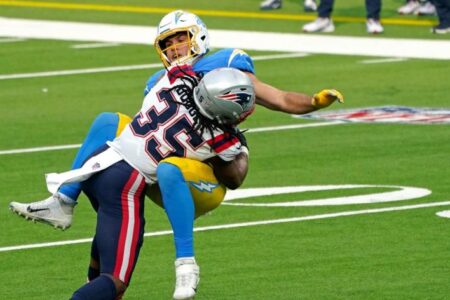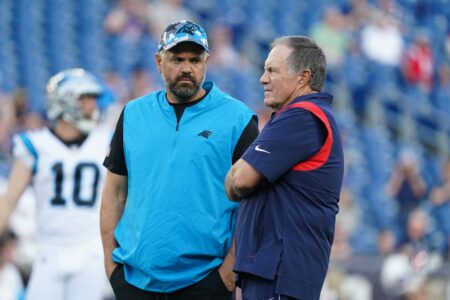All the Welker talk got me thinking about how to rate the quality of WR. I am 100% bonafide *not* a statistician, but I like to fiddle around with numbers. I have come up with four formulas for determining WR ratings. I won't get too into the formula, but here's the basic idea.
1. Productivity. This measures how, um, productive a receiver is. It takes into account receptions, yards, TD, first downs, and fumbles. Each item is weighted (thus a TD doesn't count the same as a reception, etc.). To give you an idea, here are a few guys and their Productivity Ratings. Note: there were 451 players that caught passes in the NFL this past year. The "AVG" is the average of all 451 players (this includes one reception by Joe Flacco).
AVG: 7.84
Calvin Johnson: 49.11
Wes Welker: 44.59
Deion Branch: 20.82
Mike Wallace: 31.53
Reggie Wayne: 26.10
2. Efficiency. This measures how efficient a player was in turning a reception into a yards, first downs, and touchdowns. So a player that has 1 rec, 20 yds, 1 td is more efficient than a player that has 5 rec, 20 yds, and 1 td. Here are those same players and their Efficiency Ratings:
AVG: 24.52
Calvin Johnson: 33.26
Wes Welker: 27.04
Deion Branch: 27.70
Mike Wallace: 31.58
Reggie Wayne: 25.73
3. Danger. This measures how dangerous a receiver was in turning a reception into a big play, so it takes into account TD/rec, ypc, YAC, etc. Again, the same players and their Danger Rating:
AVG: 19.62
Calvin Johnson: 27.96
Wes Welker: 21.36
Deion Branch: 23.25
Mike Wallace: 27.06
Reggie Wayne: 18.63
4. Total Receiver Rating. This simply adds up the three ratings, with productivity rating being weighted most heavily, followed by efficiency rating, and lastly, danger rating. The reason I weighted them this way is because a player could have just a handful of catches all year but they all go for big plays. Is that player a "better" receiver than a guy with a TON more receptions, yards, and TD, even if his "danger rating" is a little bit lower? Not in my book. But the Danger Rating is a factor. Again, the same guys:
AVG: 72.09
Calvin Johnson: 176.07
Wes Welker: 151.10
Deion Branch: 106.44
Mike Wallace: 137.49
Reggie Wayne: 109.41
I'm sure there are huge flaws in my metrics, but it at least gives me something to go on. Based on these admittedly flawed (but very fun) stats, here's the top ten guys in each category (min 48 rec):
Productivity
1. C. Johnson, Det - 49.11
2. Gronkowski, NE - 46.17
3. Welker, NE - 44.59
4. Graham, NO - 40.40
5. Nelson, GB - 39.13
6. White, Atl - 38.66
7. Cruz, NYG - 37.46
8. Fitzgerald, Ari - 36.21
9. Colston, NO - 31.93
10. Nicks, NYG - 31.92
Efficiency
1. Nelson, GB - 34.80
2. Jackson, SD - 34.12
3. C. Johnson, Det - 33.26
4. Cruz, NYG - 33.25
5. Wallace, Pit - 31.58
6. Gronkowski, NE - 31.51
7. Fitzgerald, Ari - 31.45
8. Smith, Car - 31.32
9. Robinson, Dal - 31.27
10. Jones, Atl - 31.20
Danger
1. Cruz, NYG - 30.10
2. Jones, Atl - 29.97
3. Nelson, GB - 29.91
4. Smith, Car - 28.16
5. Jackson, SD - 27.12
6. Wallace, Pit - 27.06
7. Gronkowski, NE - 26.32
8. Baldwin, Sea - 26.11
9. Foster, Hou - 25.66
10. Smith, Bal - 25.56
TOTAL RATING
1. C. Johnson, Det - 190.65
2. Gronkowski, NE - 176.07
3. Nelson, GB - 165.93
4. Cruz, NYG - 154.90
5. Welker, NE - 151.10
6. Fitzgerald, Ari - 147.49
7. Graham, NO - 144.31
8. Jackson, SD - 141.21
9. Wallace, Pit - 137.49
10. Smith, Car - 137.42
Here's the Pats' key receivers (Welker, Gronk, Hernandez, and Branch) and where they ranked in each category (again, minimum of 48 receptions to qualify):
Productivity
Welker - 44.59, #3
Gronkowski - 46.17, #2
Hernandez - 27.60, #23
Branch - 20.82, #49
Efficiency
Welker - 27.04, #35
Gronkowski - 31.51, #6
Hernandez - 25.20, #51
Branch - 27.70, #28
Danger
Welker - 21.36, #29
Gronkowski - 26.32, #7
Hernandez - 20.47, #35
Branch - 23.25, #19
Total Rating
Welker - 151.10, #5
Gronkowski - 176.07, #2
Hernandez - 113.47, #27
Branch - 106.44, #41
Again, very flawed number-crunching, but when I look at the lists and how the rankings came out, I think they're pretty much in line with what you'd think. The only interesting part was that I figured Hernandez would be more "dangerous" than Welker or Branch, but in reality, his numbers in those key areas weren't as impressive as I thought they would be, and Branch's were better than I thought they would be.
But as a whole group, man, four of the top 41 in the league (again, min 48 receptions)? Well, I guess it kind of makes sense given how prolific the Pats' passing offense was this season.
1. Productivity. This measures how, um, productive a receiver is. It takes into account receptions, yards, TD, first downs, and fumbles. Each item is weighted (thus a TD doesn't count the same as a reception, etc.). To give you an idea, here are a few guys and their Productivity Ratings. Note: there were 451 players that caught passes in the NFL this past year. The "AVG" is the average of all 451 players (this includes one reception by Joe Flacco).
AVG: 7.84
Calvin Johnson: 49.11
Wes Welker: 44.59
Deion Branch: 20.82
Mike Wallace: 31.53
Reggie Wayne: 26.10
2. Efficiency. This measures how efficient a player was in turning a reception into a yards, first downs, and touchdowns. So a player that has 1 rec, 20 yds, 1 td is more efficient than a player that has 5 rec, 20 yds, and 1 td. Here are those same players and their Efficiency Ratings:
AVG: 24.52
Calvin Johnson: 33.26
Wes Welker: 27.04
Deion Branch: 27.70
Mike Wallace: 31.58
Reggie Wayne: 25.73
3. Danger. This measures how dangerous a receiver was in turning a reception into a big play, so it takes into account TD/rec, ypc, YAC, etc. Again, the same players and their Danger Rating:
AVG: 19.62
Calvin Johnson: 27.96
Wes Welker: 21.36
Deion Branch: 23.25
Mike Wallace: 27.06
Reggie Wayne: 18.63
4. Total Receiver Rating. This simply adds up the three ratings, with productivity rating being weighted most heavily, followed by efficiency rating, and lastly, danger rating. The reason I weighted them this way is because a player could have just a handful of catches all year but they all go for big plays. Is that player a "better" receiver than a guy with a TON more receptions, yards, and TD, even if his "danger rating" is a little bit lower? Not in my book. But the Danger Rating is a factor. Again, the same guys:
AVG: 72.09
Calvin Johnson: 176.07
Wes Welker: 151.10
Deion Branch: 106.44
Mike Wallace: 137.49
Reggie Wayne: 109.41
I'm sure there are huge flaws in my metrics, but it at least gives me something to go on. Based on these admittedly flawed (but very fun) stats, here's the top ten guys in each category (min 48 rec):
Productivity
1. C. Johnson, Det - 49.11
2. Gronkowski, NE - 46.17
3. Welker, NE - 44.59
4. Graham, NO - 40.40
5. Nelson, GB - 39.13
6. White, Atl - 38.66
7. Cruz, NYG - 37.46
8. Fitzgerald, Ari - 36.21
9. Colston, NO - 31.93
10. Nicks, NYG - 31.92
Efficiency
1. Nelson, GB - 34.80
2. Jackson, SD - 34.12
3. C. Johnson, Det - 33.26
4. Cruz, NYG - 33.25
5. Wallace, Pit - 31.58
6. Gronkowski, NE - 31.51
7. Fitzgerald, Ari - 31.45
8. Smith, Car - 31.32
9. Robinson, Dal - 31.27
10. Jones, Atl - 31.20
Danger
1. Cruz, NYG - 30.10
2. Jones, Atl - 29.97
3. Nelson, GB - 29.91
4. Smith, Car - 28.16
5. Jackson, SD - 27.12
6. Wallace, Pit - 27.06
7. Gronkowski, NE - 26.32
8. Baldwin, Sea - 26.11
9. Foster, Hou - 25.66
10. Smith, Bal - 25.56
TOTAL RATING
1. C. Johnson, Det - 190.65
2. Gronkowski, NE - 176.07
3. Nelson, GB - 165.93
4. Cruz, NYG - 154.90
5. Welker, NE - 151.10
6. Fitzgerald, Ari - 147.49
7. Graham, NO - 144.31
8. Jackson, SD - 141.21
9. Wallace, Pit - 137.49
10. Smith, Car - 137.42
Here's the Pats' key receivers (Welker, Gronk, Hernandez, and Branch) and where they ranked in each category (again, minimum of 48 receptions to qualify):
Productivity
Welker - 44.59, #3
Gronkowski - 46.17, #2
Hernandez - 27.60, #23
Branch - 20.82, #49
Efficiency
Welker - 27.04, #35
Gronkowski - 31.51, #6
Hernandez - 25.20, #51
Branch - 27.70, #28
Danger
Welker - 21.36, #29
Gronkowski - 26.32, #7
Hernandez - 20.47, #35
Branch - 23.25, #19
Total Rating
Welker - 151.10, #5
Gronkowski - 176.07, #2
Hernandez - 113.47, #27
Branch - 106.44, #41
Again, very flawed number-crunching, but when I look at the lists and how the rankings came out, I think they're pretty much in line with what you'd think. The only interesting part was that I figured Hernandez would be more "dangerous" than Welker or Branch, but in reality, his numbers in those key areas weren't as impressive as I thought they would be, and Branch's were better than I thought they would be.
But as a whole group, man, four of the top 41 in the league (again, min 48 receptions)? Well, I guess it kind of makes sense given how prolific the Pats' passing offense was this season.


















